Nutritious Status of Aboriginals
VerifiedAdded on 2023/01/23
|10
|2380
|63
AI Summary
This essay critically evaluates the media item based on the nutritious status of Aboriginals and Torres Strait islander, exploring current health issues affecting their health and wellbeing. It examines key measures, health issues, and evaluates the quality of the media item. The impact of the evaluation on the reader is also discussed.
Contribute Materials
Your contribution can guide someone’s learning journey. Share your
documents today.

Running head: NUTRITIOUS STATUS OF ABORIGINALS
NUTRITIOUS STATUS OF ABORIGINALS
Name of Student:
Name of University:
Author’s Note:
NUTRITIOUS STATUS OF ABORIGINALS
Name of Student:
Name of University:
Author’s Note:
Secure Best Marks with AI Grader
Need help grading? Try our AI Grader for instant feedback on your assignments.
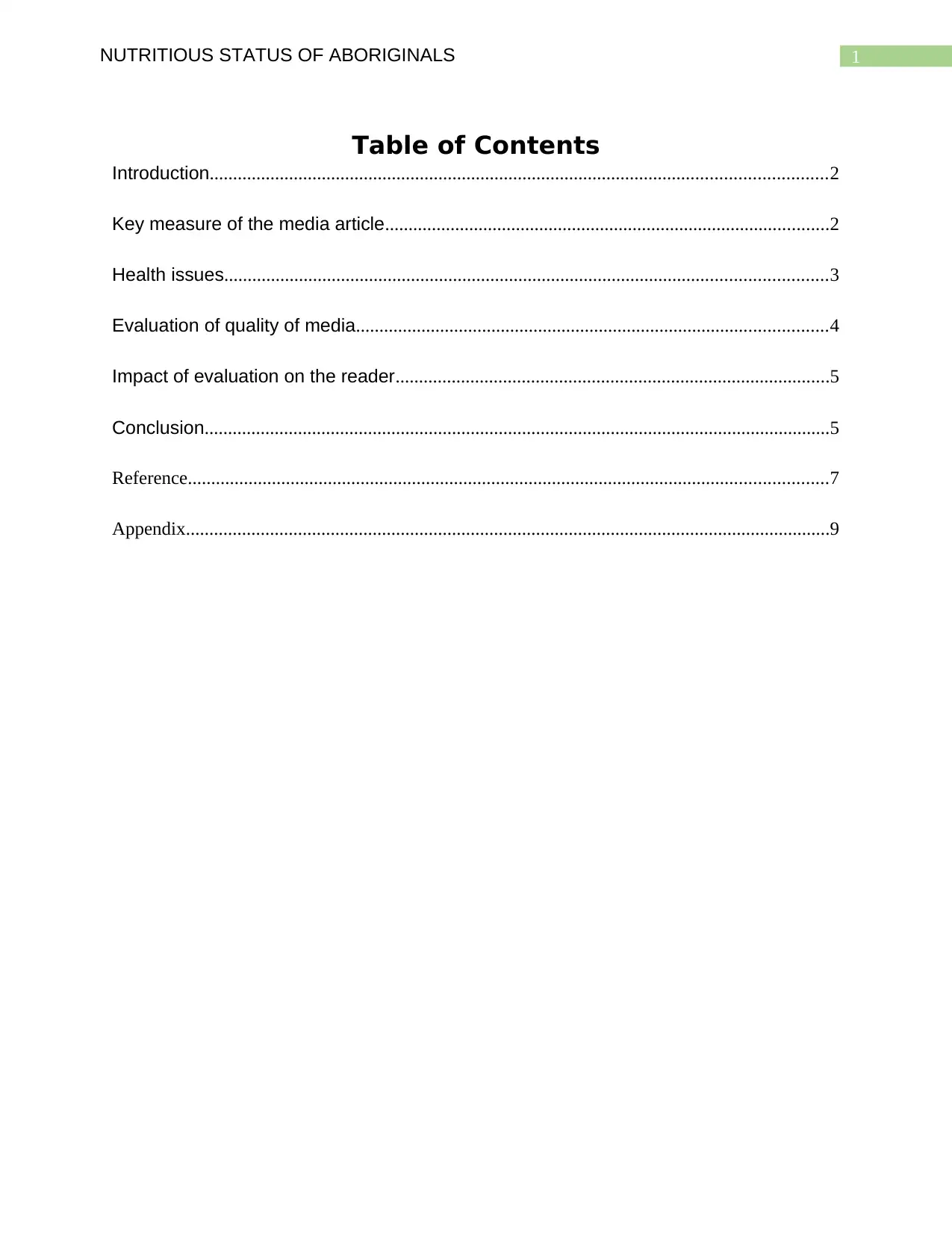
1NUTRITIOUS STATUS OF ABORIGINALS
Table of Contents
Introduction....................................................................................................................................2
Key measure of the media article...............................................................................................2
Health issues.................................................................................................................................3
Evaluation of quality of media.....................................................................................................4
Impact of evaluation on the reader.............................................................................................5
Conclusion......................................................................................................................................5
Reference.........................................................................................................................................7
Appendix..........................................................................................................................................9
Table of Contents
Introduction....................................................................................................................................2
Key measure of the media article...............................................................................................2
Health issues.................................................................................................................................3
Evaluation of quality of media.....................................................................................................4
Impact of evaluation on the reader.............................................................................................5
Conclusion......................................................................................................................................5
Reference.........................................................................................................................................7
Appendix..........................................................................................................................................9
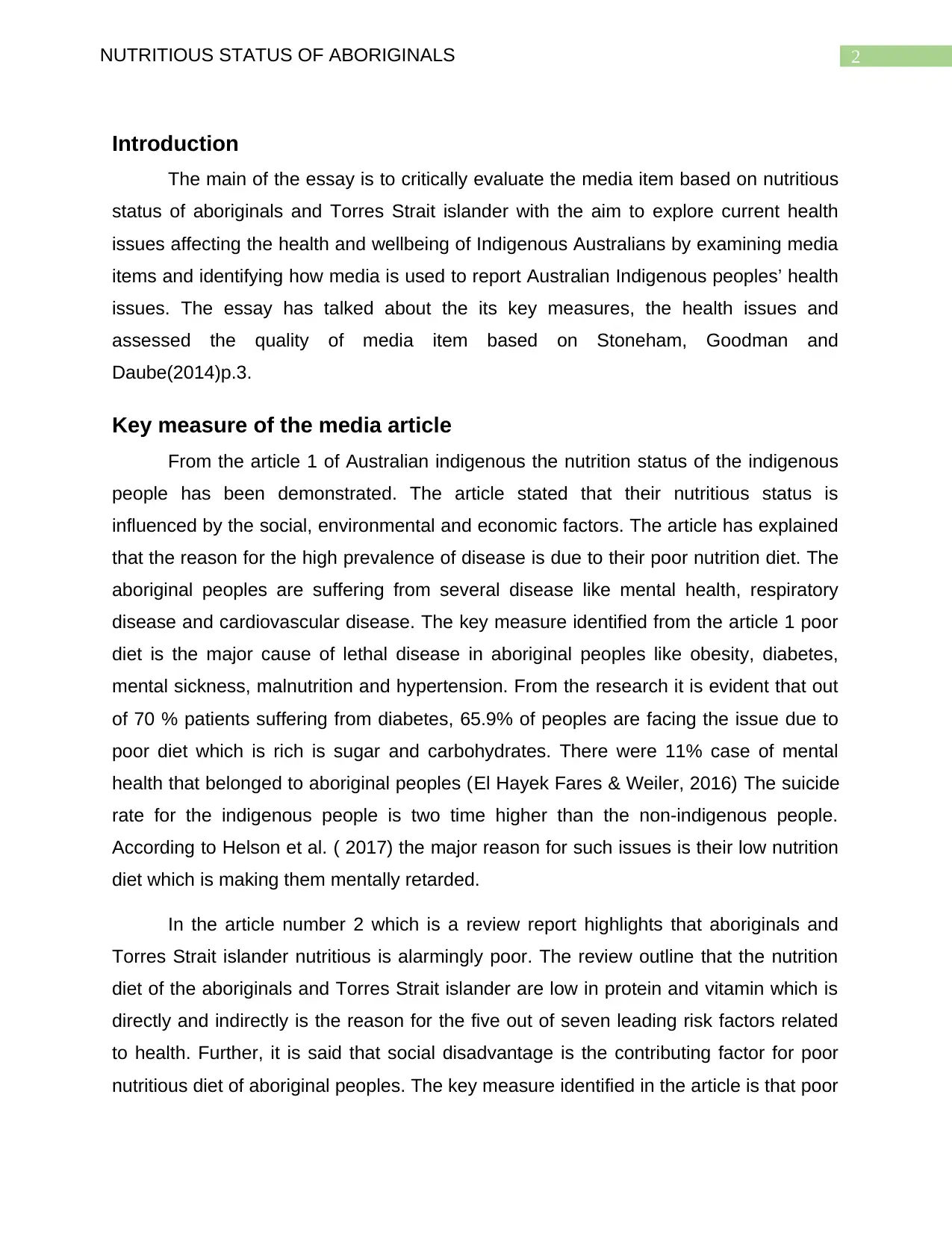
2NUTRITIOUS STATUS OF ABORIGINALS
Introduction
The main of the essay is to critically evaluate the media item based on nutritious
status of aboriginals and Torres Strait islander with the aim to explore current health
issues affecting the health and wellbeing of Indigenous Australians by examining media
items and identifying how media is used to report Australian Indigenous peoples’ health
issues. The essay has talked about the its key measures, the health issues and
assessed the quality of media item based on Stoneham, Goodman and
Daube(2014)p.3.
Key measure of the media article
From the article 1 of Australian indigenous the nutrition status of the indigenous
people has been demonstrated. The article stated that their nutritious status is
influenced by the social, environmental and economic factors. The article has explained
that the reason for the high prevalence of disease is due to their poor nutrition diet. The
aboriginal peoples are suffering from several disease like mental health, respiratory
disease and cardiovascular disease. The key measure identified from the article 1 poor
diet is the major cause of lethal disease in aboriginal peoples like obesity, diabetes,
mental sickness, malnutrition and hypertension. From the research it is evident that out
of 70 % patients suffering from diabetes, 65.9% of peoples are facing the issue due to
poor diet which is rich is sugar and carbohydrates. There were 11% case of mental
health that belonged to aboriginal peoples (El Hayek Fares & Weiler, 2016) The suicide
rate for the indigenous people is two time higher than the non-indigenous people.
According to Helson et al. ( 2017) the major reason for such issues is their low nutrition
diet which is making them mentally retarded.
In the article number 2 which is a review report highlights that aboriginals and
Torres Strait islander nutritious is alarmingly poor. The review outline that the nutrition
diet of the aboriginals and Torres Strait islander are low in protein and vitamin which is
directly and indirectly is the reason for the five out of seven leading risk factors related
to health. Further, it is said that social disadvantage is the contributing factor for poor
nutritious diet of aboriginal peoples. The key measure identified in the article is that poor
Introduction
The main of the essay is to critically evaluate the media item based on nutritious
status of aboriginals and Torres Strait islander with the aim to explore current health
issues affecting the health and wellbeing of Indigenous Australians by examining media
items and identifying how media is used to report Australian Indigenous peoples’ health
issues. The essay has talked about the its key measures, the health issues and
assessed the quality of media item based on Stoneham, Goodman and
Daube(2014)p.3.
Key measure of the media article
From the article 1 of Australian indigenous the nutrition status of the indigenous
people has been demonstrated. The article stated that their nutritious status is
influenced by the social, environmental and economic factors. The article has explained
that the reason for the high prevalence of disease is due to their poor nutrition diet. The
aboriginal peoples are suffering from several disease like mental health, respiratory
disease and cardiovascular disease. The key measure identified from the article 1 poor
diet is the major cause of lethal disease in aboriginal peoples like obesity, diabetes,
mental sickness, malnutrition and hypertension. From the research it is evident that out
of 70 % patients suffering from diabetes, 65.9% of peoples are facing the issue due to
poor diet which is rich is sugar and carbohydrates. There were 11% case of mental
health that belonged to aboriginal peoples (El Hayek Fares & Weiler, 2016) The suicide
rate for the indigenous people is two time higher than the non-indigenous people.
According to Helson et al. ( 2017) the major reason for such issues is their low nutrition
diet which is making them mentally retarded.
In the article number 2 which is a review report highlights that aboriginals and
Torres Strait islander nutritious is alarmingly poor. The review outline that the nutrition
diet of the aboriginals and Torres Strait islander are low in protein and vitamin which is
directly and indirectly is the reason for the five out of seven leading risk factors related
to health. Further, it is said that social disadvantage is the contributing factor for poor
nutritious diet of aboriginal peoples. The key measure identified in the article is that poor
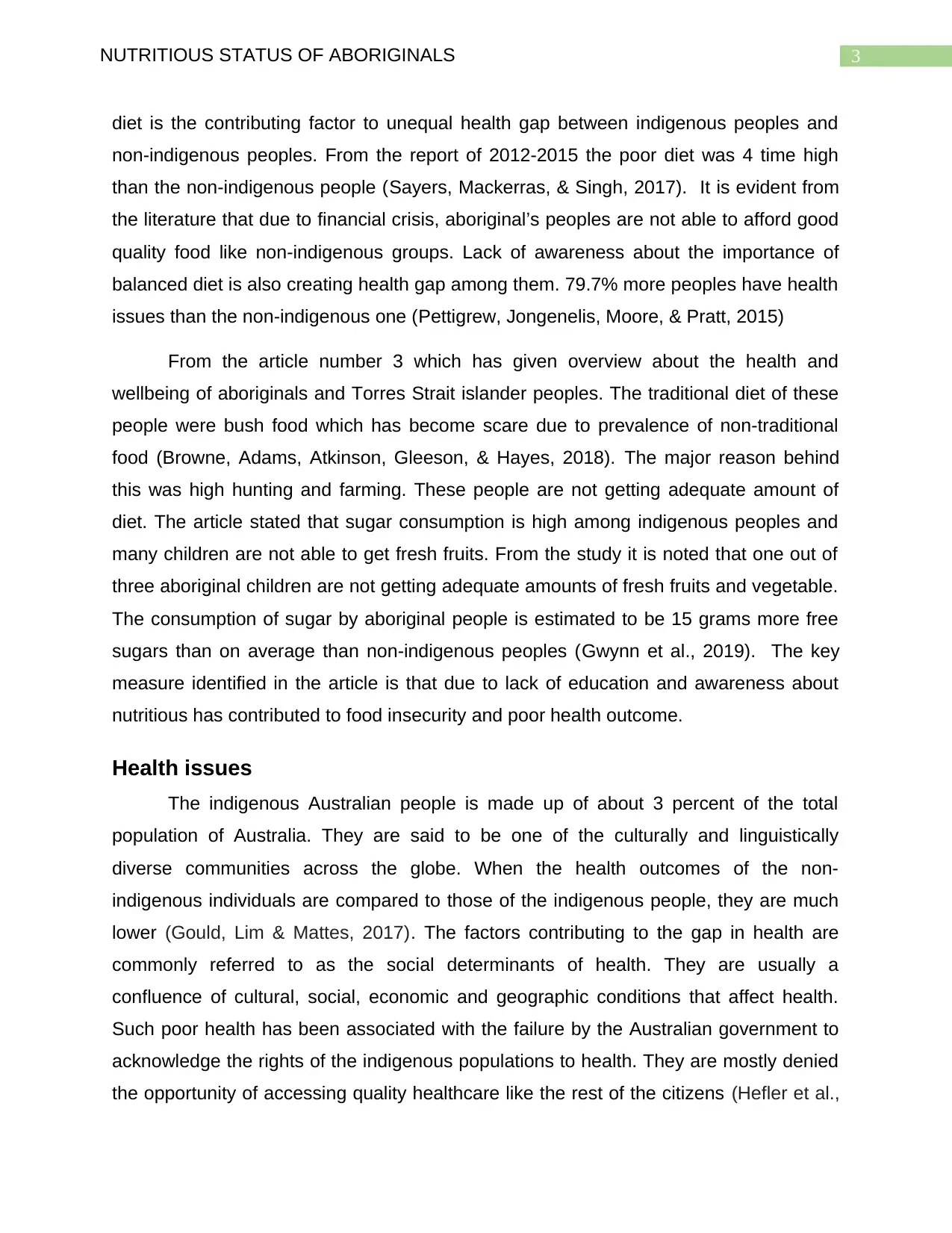
3NUTRITIOUS STATUS OF ABORIGINALS
diet is the contributing factor to unequal health gap between indigenous peoples and
non-indigenous peoples. From the report of 2012-2015 the poor diet was 4 time high
than the non-indigenous people (Sayers, Mackerras, & Singh, 2017). It is evident from
the literature that due to financial crisis, aboriginal’s peoples are not able to afford good
quality food like non-indigenous groups. Lack of awareness about the importance of
balanced diet is also creating health gap among them. 79.7% more peoples have health
issues than the non-indigenous one (Pettigrew, Jongenelis, Moore, & Pratt, 2015)
From the article number 3 which has given overview about the health and
wellbeing of aboriginals and Torres Strait islander peoples. The traditional diet of these
people were bush food which has become scare due to prevalence of non-traditional
food (Browne, Adams, Atkinson, Gleeson, & Hayes, 2018). The major reason behind
this was high hunting and farming. These people are not getting adequate amount of
diet. The article stated that sugar consumption is high among indigenous peoples and
many children are not able to get fresh fruits. From the study it is noted that one out of
three aboriginal children are not getting adequate amounts of fresh fruits and vegetable.
The consumption of sugar by aboriginal people is estimated to be 15 grams more free
sugars than on average than non-indigenous peoples (Gwynn et al., 2019). The key
measure identified in the article is that due to lack of education and awareness about
nutritious has contributed to food insecurity and poor health outcome.
Health issues
The indigenous Australian people is made up of about 3 percent of the total
population of Australia. They are said to be one of the culturally and linguistically
diverse communities across the globe. When the health outcomes of the non-
indigenous individuals are compared to those of the indigenous people, they are much
lower (Gould, Lim & Mattes, 2017). The factors contributing to the gap in health are
commonly referred to as the social determinants of health. They are usually a
confluence of cultural, social, economic and geographic conditions that affect health.
Such poor health has been associated with the failure by the Australian government to
acknowledge the rights of the indigenous populations to health. They are mostly denied
the opportunity of accessing quality healthcare like the rest of the citizens (Hefler et al.,
diet is the contributing factor to unequal health gap between indigenous peoples and
non-indigenous peoples. From the report of 2012-2015 the poor diet was 4 time high
than the non-indigenous people (Sayers, Mackerras, & Singh, 2017). It is evident from
the literature that due to financial crisis, aboriginal’s peoples are not able to afford good
quality food like non-indigenous groups. Lack of awareness about the importance of
balanced diet is also creating health gap among them. 79.7% more peoples have health
issues than the non-indigenous one (Pettigrew, Jongenelis, Moore, & Pratt, 2015)
From the article number 3 which has given overview about the health and
wellbeing of aboriginals and Torres Strait islander peoples. The traditional diet of these
people were bush food which has become scare due to prevalence of non-traditional
food (Browne, Adams, Atkinson, Gleeson, & Hayes, 2018). The major reason behind
this was high hunting and farming. These people are not getting adequate amount of
diet. The article stated that sugar consumption is high among indigenous peoples and
many children are not able to get fresh fruits. From the study it is noted that one out of
three aboriginal children are not getting adequate amounts of fresh fruits and vegetable.
The consumption of sugar by aboriginal people is estimated to be 15 grams more free
sugars than on average than non-indigenous peoples (Gwynn et al., 2019). The key
measure identified in the article is that due to lack of education and awareness about
nutritious has contributed to food insecurity and poor health outcome.
Health issues
The indigenous Australian people is made up of about 3 percent of the total
population of Australia. They are said to be one of the culturally and linguistically
diverse communities across the globe. When the health outcomes of the non-
indigenous individuals are compared to those of the indigenous people, they are much
lower (Gould, Lim & Mattes, 2017). The factors contributing to the gap in health are
commonly referred to as the social determinants of health. They are usually a
confluence of cultural, social, economic and geographic conditions that affect health.
Such poor health has been associated with the failure by the Australian government to
acknowledge the rights of the indigenous populations to health. They are mostly denied
the opportunity of accessing quality healthcare like the rest of the citizens (Hefler et al.,
Secure Best Marks with AI Grader
Need help grading? Try our AI Grader for instant feedback on your assignments.
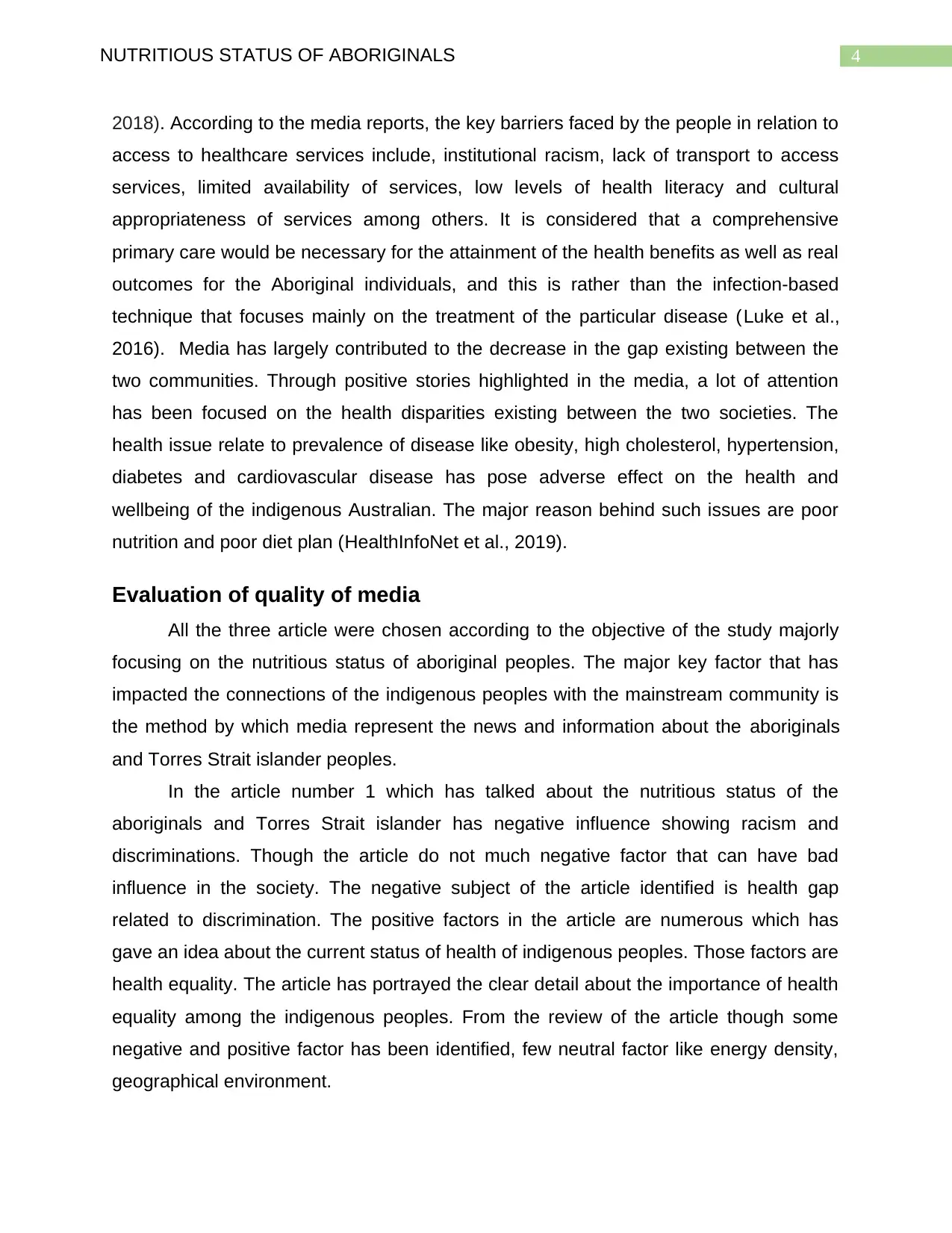
4NUTRITIOUS STATUS OF ABORIGINALS
2018). According to the media reports, the key barriers faced by the people in relation to
access to healthcare services include, institutional racism, lack of transport to access
services, limited availability of services, low levels of health literacy and cultural
appropriateness of services among others. It is considered that a comprehensive
primary care would be necessary for the attainment of the health benefits as well as real
outcomes for the Aboriginal individuals, and this is rather than the infection-based
technique that focuses mainly on the treatment of the particular disease (Luke et al.,
2016). Media has largely contributed to the decrease in the gap existing between the
two communities. Through positive stories highlighted in the media, a lot of attention
has been focused on the health disparities existing between the two societies. The
health issue relate to prevalence of disease like obesity, high cholesterol, hypertension,
diabetes and cardiovascular disease has pose adverse effect on the health and
wellbeing of the indigenous Australian. The major reason behind such issues are poor
nutrition and poor diet plan (HealthInfoNet et al., 2019).
Evaluation of quality of media
All the three article were chosen according to the objective of the study majorly
focusing on the nutritious status of aboriginal peoples. The major key factor that has
impacted the connections of the indigenous peoples with the mainstream community is
the method by which media represent the news and information about the aboriginals
and Torres Strait islander peoples.
In the article number 1 which has talked about the nutritious status of the
aboriginals and Torres Strait islander has negative influence showing racism and
discriminations. Though the article do not much negative factor that can have bad
influence in the society. The negative subject of the article identified is health gap
related to discrimination. The positive factors in the article are numerous which has
gave an idea about the current status of health of indigenous peoples. Those factors are
health equality. The article has portrayed the clear detail about the importance of health
equality among the indigenous peoples. From the review of the article though some
negative and positive factor has been identified, few neutral factor like energy density,
geographical environment.
2018). According to the media reports, the key barriers faced by the people in relation to
access to healthcare services include, institutional racism, lack of transport to access
services, limited availability of services, low levels of health literacy and cultural
appropriateness of services among others. It is considered that a comprehensive
primary care would be necessary for the attainment of the health benefits as well as real
outcomes for the Aboriginal individuals, and this is rather than the infection-based
technique that focuses mainly on the treatment of the particular disease (Luke et al.,
2016). Media has largely contributed to the decrease in the gap existing between the
two communities. Through positive stories highlighted in the media, a lot of attention
has been focused on the health disparities existing between the two societies. The
health issue relate to prevalence of disease like obesity, high cholesterol, hypertension,
diabetes and cardiovascular disease has pose adverse effect on the health and
wellbeing of the indigenous Australian. The major reason behind such issues are poor
nutrition and poor diet plan (HealthInfoNet et al., 2019).
Evaluation of quality of media
All the three article were chosen according to the objective of the study majorly
focusing on the nutritious status of aboriginal peoples. The major key factor that has
impacted the connections of the indigenous peoples with the mainstream community is
the method by which media represent the news and information about the aboriginals
and Torres Strait islander peoples.
In the article number 1 which has talked about the nutritious status of the
aboriginals and Torres Strait islander has negative influence showing racism and
discriminations. Though the article do not much negative factor that can have bad
influence in the society. The negative subject of the article identified is health gap
related to discrimination. The positive factors in the article are numerous which has
gave an idea about the current status of health of indigenous peoples. Those factors are
health equality. The article has portrayed the clear detail about the importance of health
equality among the indigenous peoples. From the review of the article though some
negative and positive factor has been identified, few neutral factor like energy density,
geographical environment.
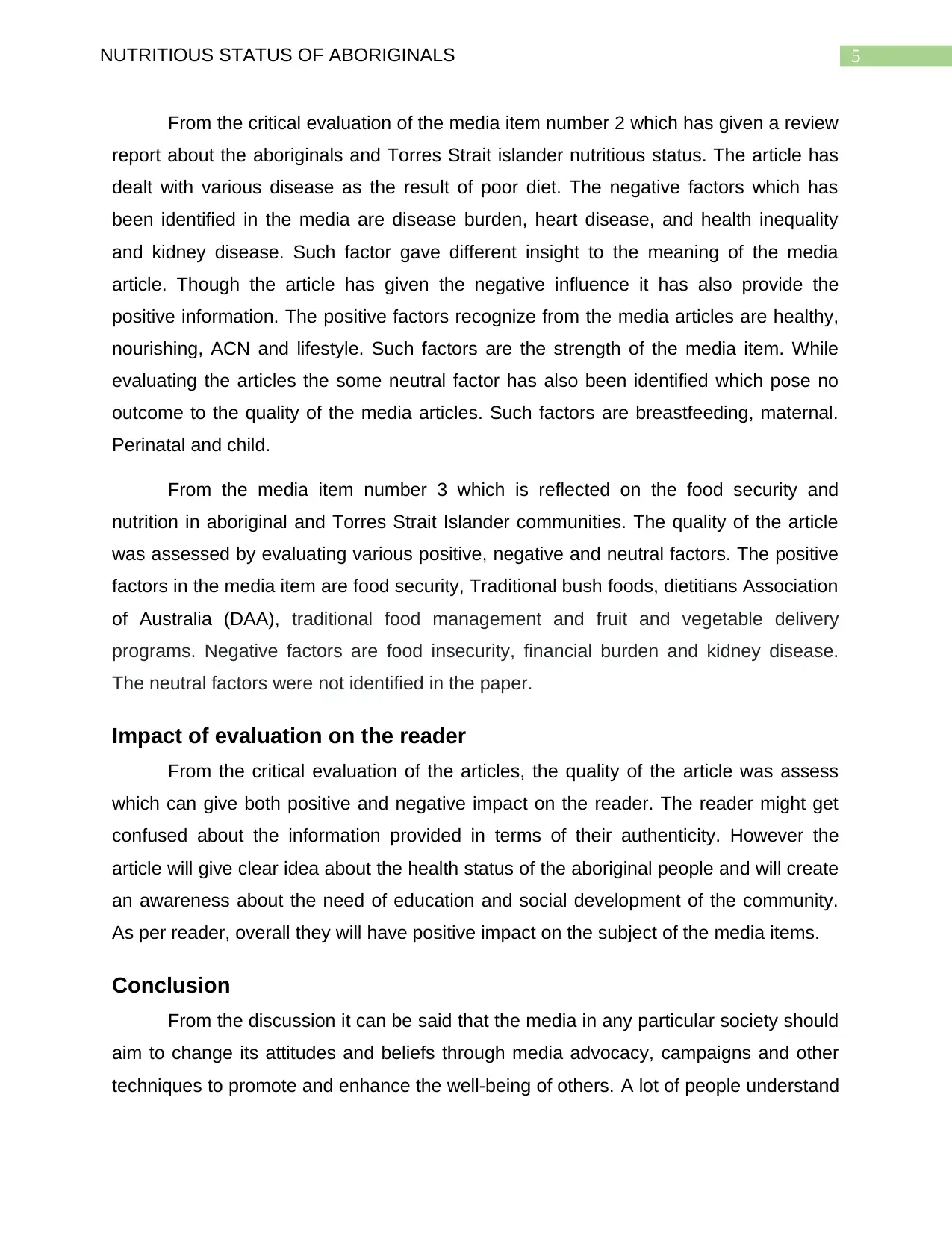
5NUTRITIOUS STATUS OF ABORIGINALS
From the critical evaluation of the media item number 2 which has given a review
report about the aboriginals and Torres Strait islander nutritious status. The article has
dealt with various disease as the result of poor diet. The negative factors which has
been identified in the media are disease burden, heart disease, and health inequality
and kidney disease. Such factor gave different insight to the meaning of the media
article. Though the article has given the negative influence it has also provide the
positive information. The positive factors recognize from the media articles are healthy,
nourishing, ACN and lifestyle. Such factors are the strength of the media item. While
evaluating the articles the some neutral factor has also been identified which pose no
outcome to the quality of the media articles. Such factors are breastfeeding, maternal.
Perinatal and child.
From the media item number 3 which is reflected on the food security and
nutrition in aboriginal and Torres Strait Islander communities. The quality of the article
was assessed by evaluating various positive, negative and neutral factors. The positive
factors in the media item are food security, Traditional bush foods, dietitians Association
of Australia (DAA), traditional food management and fruit and vegetable delivery
programs. Negative factors are food insecurity, financial burden and kidney disease.
The neutral factors were not identified in the paper.
Impact of evaluation on the reader
From the critical evaluation of the articles, the quality of the article was assess
which can give both positive and negative impact on the reader. The reader might get
confused about the information provided in terms of their authenticity. However the
article will give clear idea about the health status of the aboriginal people and will create
an awareness about the need of education and social development of the community.
As per reader, overall they will have positive impact on the subject of the media items.
Conclusion
From the discussion it can be said that the media in any particular society should
aim to change its attitudes and beliefs through media advocacy, campaigns and other
techniques to promote and enhance the well-being of others. A lot of people understand
From the critical evaluation of the media item number 2 which has given a review
report about the aboriginals and Torres Strait islander nutritious status. The article has
dealt with various disease as the result of poor diet. The negative factors which has
been identified in the media are disease burden, heart disease, and health inequality
and kidney disease. Such factor gave different insight to the meaning of the media
article. Though the article has given the negative influence it has also provide the
positive information. The positive factors recognize from the media articles are healthy,
nourishing, ACN and lifestyle. Such factors are the strength of the media item. While
evaluating the articles the some neutral factor has also been identified which pose no
outcome to the quality of the media articles. Such factors are breastfeeding, maternal.
Perinatal and child.
From the media item number 3 which is reflected on the food security and
nutrition in aboriginal and Torres Strait Islander communities. The quality of the article
was assessed by evaluating various positive, negative and neutral factors. The positive
factors in the media item are food security, Traditional bush foods, dietitians Association
of Australia (DAA), traditional food management and fruit and vegetable delivery
programs. Negative factors are food insecurity, financial burden and kidney disease.
The neutral factors were not identified in the paper.
Impact of evaluation on the reader
From the critical evaluation of the articles, the quality of the article was assess
which can give both positive and negative impact on the reader. The reader might get
confused about the information provided in terms of their authenticity. However the
article will give clear idea about the health status of the aboriginal people and will create
an awareness about the need of education and social development of the community.
As per reader, overall they will have positive impact on the subject of the media items.
Conclusion
From the discussion it can be said that the media in any particular society should
aim to change its attitudes and beliefs through media advocacy, campaigns and other
techniques to promote and enhance the well-being of others. A lot of people understand

6NUTRITIOUS STATUS OF ABORIGINALS
that with good nutrition and physical activity will help in the maintenance of a healthy
weight. However, the benefits of nutrition are far much beyond the good weight. The
media has shifted its focus to the creation of certain positive stories aimed at displaying
how different individuals as well as organizations have enhanced the well-being as well
as the health of the members of the society.
that with good nutrition and physical activity will help in the maintenance of a healthy
weight. However, the benefits of nutrition are far much beyond the good weight. The
media has shifted its focus to the creation of certain positive stories aimed at displaying
how different individuals as well as organizations have enhanced the well-being as well
as the health of the members of the society.
Paraphrase This Document
Need a fresh take? Get an instant paraphrase of this document with our AI Paraphraser
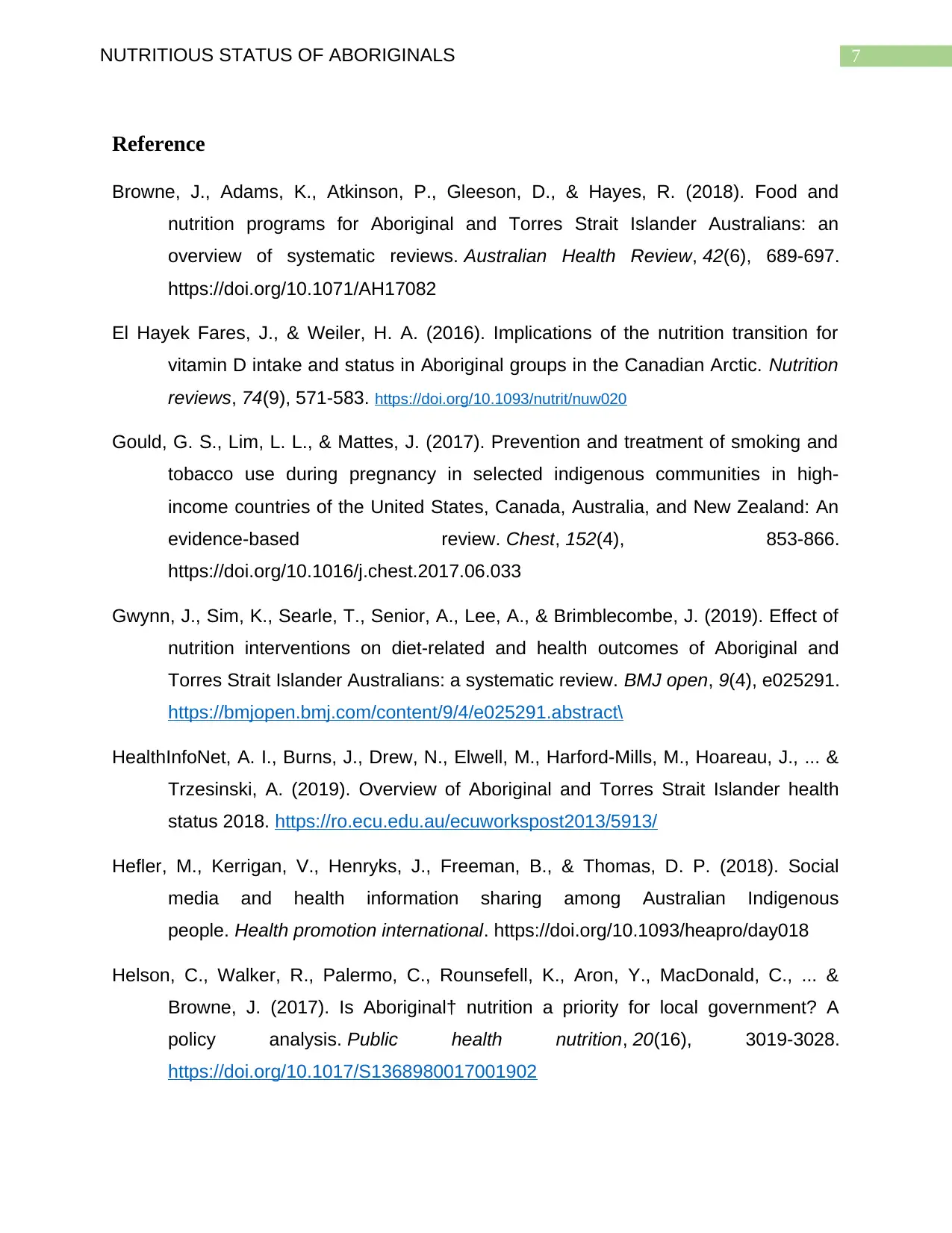
7NUTRITIOUS STATUS OF ABORIGINALS
Reference
Browne, J., Adams, K., Atkinson, P., Gleeson, D., & Hayes, R. (2018). Food and
nutrition programs for Aboriginal and Torres Strait Islander Australians: an
overview of systematic reviews. Australian Health Review, 42(6), 689-697.
https://doi.org/10.1071/AH17082
El Hayek Fares, J., & Weiler, H. A. (2016). Implications of the nutrition transition for
vitamin D intake and status in Aboriginal groups in the Canadian Arctic. Nutrition
reviews, 74(9), 571-583. https://doi.org/10.1093/nutrit/nuw020
Gould, G. S., Lim, L. L., & Mattes, J. (2017). Prevention and treatment of smoking and
tobacco use during pregnancy in selected indigenous communities in high-
income countries of the United States, Canada, Australia, and New Zealand: An
evidence-based review. Chest, 152(4), 853-866.
https://doi.org/10.1016/j.chest.2017.06.033
Gwynn, J., Sim, K., Searle, T., Senior, A., Lee, A., & Brimblecombe, J. (2019). Effect of
nutrition interventions on diet-related and health outcomes of Aboriginal and
Torres Strait Islander Australians: a systematic review. BMJ open, 9(4), e025291.
https://bmjopen.bmj.com/content/9/4/e025291.abstract\
HealthInfoNet, A. I., Burns, J., Drew, N., Elwell, M., Harford-Mills, M., Hoareau, J., ... &
Trzesinski, A. (2019). Overview of Aboriginal and Torres Strait Islander health
status 2018. https://ro.ecu.edu.au/ecuworkspost2013/5913/
Hefler, M., Kerrigan, V., Henryks, J., Freeman, B., & Thomas, D. P. (2018). Social
media and health information sharing among Australian Indigenous
people. Health promotion international. https://doi.org/10.1093/heapro/day018
Helson, C., Walker, R., Palermo, C., Rounsefell, K., Aron, Y., MacDonald, C., ... &
Browne, J. (2017). Is Aboriginal† nutrition a priority for local government? A
policy analysis. Public health nutrition, 20(16), 3019-3028.
https://doi.org/10.1017/S1368980017001902
Reference
Browne, J., Adams, K., Atkinson, P., Gleeson, D., & Hayes, R. (2018). Food and
nutrition programs for Aboriginal and Torres Strait Islander Australians: an
overview of systematic reviews. Australian Health Review, 42(6), 689-697.
https://doi.org/10.1071/AH17082
El Hayek Fares, J., & Weiler, H. A. (2016). Implications of the nutrition transition for
vitamin D intake and status in Aboriginal groups in the Canadian Arctic. Nutrition
reviews, 74(9), 571-583. https://doi.org/10.1093/nutrit/nuw020
Gould, G. S., Lim, L. L., & Mattes, J. (2017). Prevention and treatment of smoking and
tobacco use during pregnancy in selected indigenous communities in high-
income countries of the United States, Canada, Australia, and New Zealand: An
evidence-based review. Chest, 152(4), 853-866.
https://doi.org/10.1016/j.chest.2017.06.033
Gwynn, J., Sim, K., Searle, T., Senior, A., Lee, A., & Brimblecombe, J. (2019). Effect of
nutrition interventions on diet-related and health outcomes of Aboriginal and
Torres Strait Islander Australians: a systematic review. BMJ open, 9(4), e025291.
https://bmjopen.bmj.com/content/9/4/e025291.abstract\
HealthInfoNet, A. I., Burns, J., Drew, N., Elwell, M., Harford-Mills, M., Hoareau, J., ... &
Trzesinski, A. (2019). Overview of Aboriginal and Torres Strait Islander health
status 2018. https://ro.ecu.edu.au/ecuworkspost2013/5913/
Hefler, M., Kerrigan, V., Henryks, J., Freeman, B., & Thomas, D. P. (2018). Social
media and health information sharing among Australian Indigenous
people. Health promotion international. https://doi.org/10.1093/heapro/day018
Helson, C., Walker, R., Palermo, C., Rounsefell, K., Aron, Y., MacDonald, C., ... &
Browne, J. (2017). Is Aboriginal† nutrition a priority for local government? A
policy analysis. Public health nutrition, 20(16), 3019-3028.
https://doi.org/10.1017/S1368980017001902
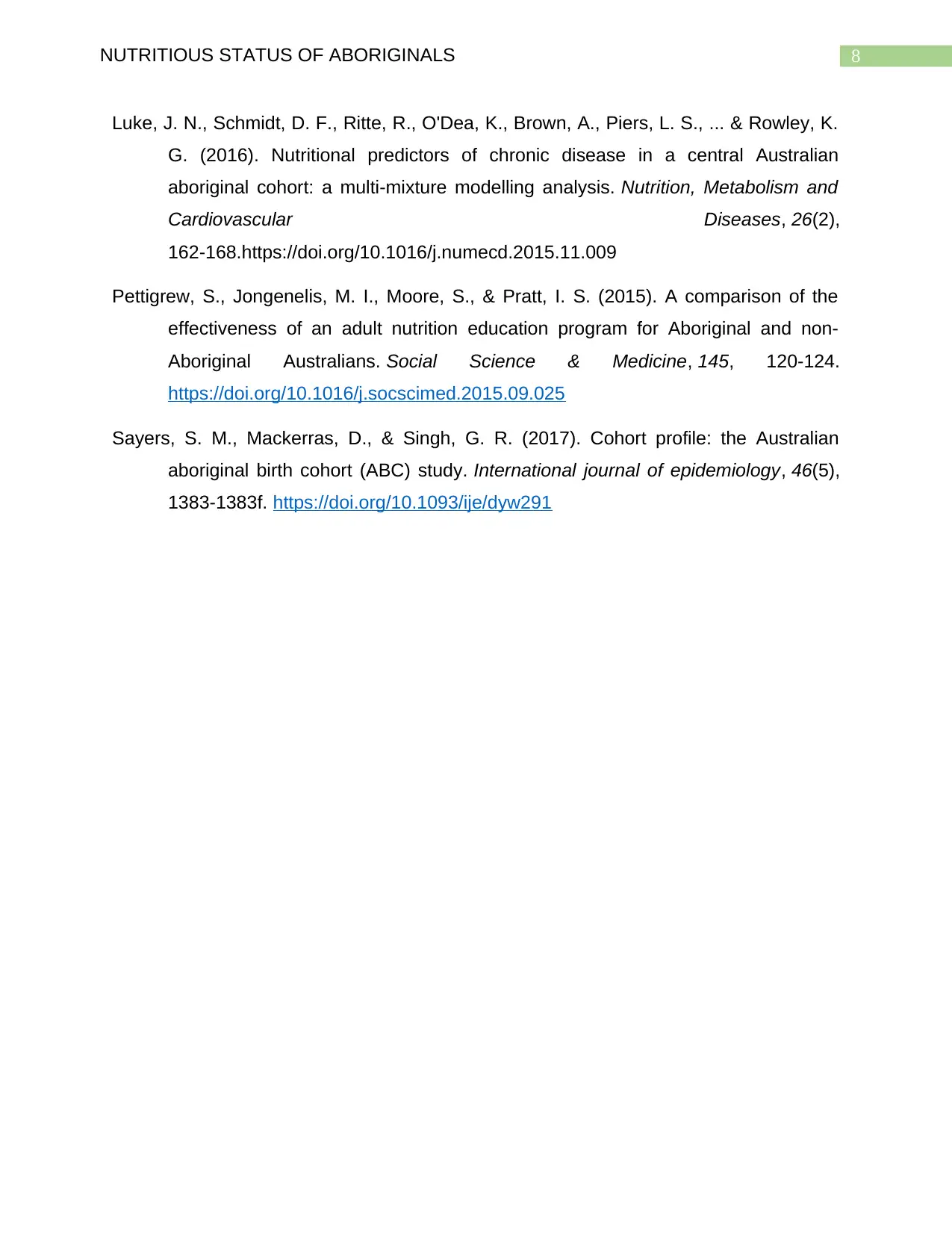
8NUTRITIOUS STATUS OF ABORIGINALS
Luke, J. N., Schmidt, D. F., Ritte, R., O'Dea, K., Brown, A., Piers, L. S., ... & Rowley, K.
G. (2016). Nutritional predictors of chronic disease in a central Australian
aboriginal cohort: a multi-mixture modelling analysis. Nutrition, Metabolism and
Cardiovascular Diseases, 26(2),
162-168.https://doi.org/10.1016/j.numecd.2015.11.009
Pettigrew, S., Jongenelis, M. I., Moore, S., & Pratt, I. S. (2015). A comparison of the
effectiveness of an adult nutrition education program for Aboriginal and non-
Aboriginal Australians. Social Science & Medicine, 145, 120-124.
https://doi.org/10.1016/j.socscimed.2015.09.025
Sayers, S. M., Mackerras, D., & Singh, G. R. (2017). Cohort profile: the Australian
aboriginal birth cohort (ABC) study. International journal of epidemiology, 46(5),
1383-1383f. https://doi.org/10.1093/ije/dyw291
Luke, J. N., Schmidt, D. F., Ritte, R., O'Dea, K., Brown, A., Piers, L. S., ... & Rowley, K.
G. (2016). Nutritional predictors of chronic disease in a central Australian
aboriginal cohort: a multi-mixture modelling analysis. Nutrition, Metabolism and
Cardiovascular Diseases, 26(2),
162-168.https://doi.org/10.1016/j.numecd.2015.11.009
Pettigrew, S., Jongenelis, M. I., Moore, S., & Pratt, I. S. (2015). A comparison of the
effectiveness of an adult nutrition education program for Aboriginal and non-
Aboriginal Australians. Social Science & Medicine, 145, 120-124.
https://doi.org/10.1016/j.socscimed.2015.09.025
Sayers, S. M., Mackerras, D., & Singh, G. R. (2017). Cohort profile: the Australian
aboriginal birth cohort (ABC) study. International journal of epidemiology, 46(5),
1383-1383f. https://doi.org/10.1093/ije/dyw291

9NUTRITIOUS STATUS OF ABORIGINALS
Appendix
Article number 1. https://healthinfonet.ecu.edu.au/learn/determinants-of-health/health-
behaviours/nutrition/
Article number 2. https://www.acn.edu.au/nurseclick/aboriginal-torres-strait-islander-nutrition-
alarmingly-poor-new-review-reports
Article number 3. https://www1.racgp.org.au/newsgp/racgp/food-security-and-nutrition-in-
aboriginal-and-torr
Appendix
Article number 1. https://healthinfonet.ecu.edu.au/learn/determinants-of-health/health-
behaviours/nutrition/
Article number 2. https://www.acn.edu.au/nurseclick/aboriginal-torres-strait-islander-nutrition-
alarmingly-poor-new-review-reports
Article number 3. https://www1.racgp.org.au/newsgp/racgp/food-security-and-nutrition-in-
aboriginal-and-torr
1 out of 10
Related Documents
Your All-in-One AI-Powered Toolkit for Academic Success.
+13062052269
info@desklib.com
Available 24*7 on WhatsApp / Email
![[object Object]](/_next/static/media/star-bottom.7253800d.svg)
Unlock your academic potential
© 2024 | Zucol Services PVT LTD | All rights reserved.





